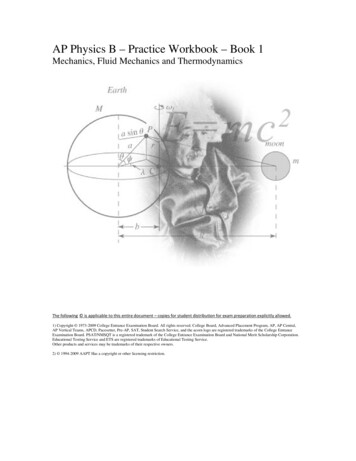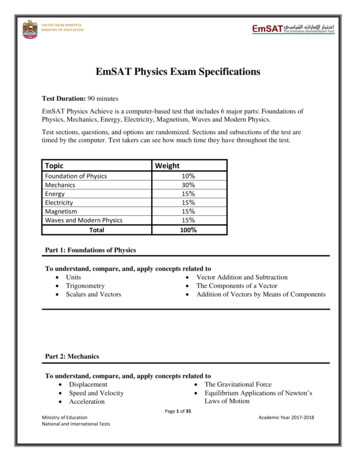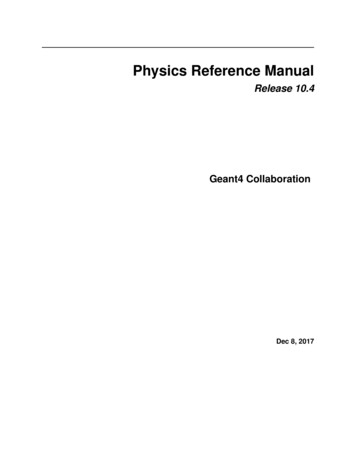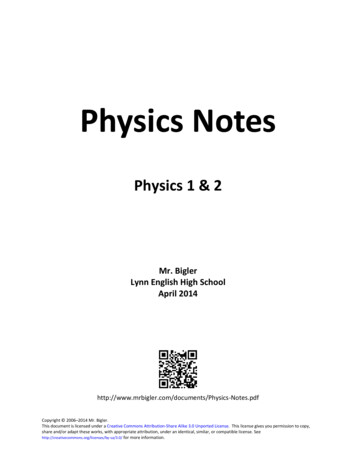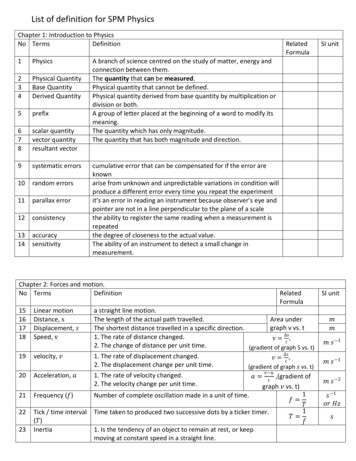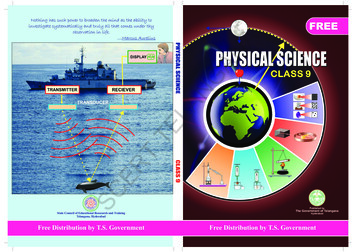
Transcription
TERSCNGLATEANA
The ScientistINSPIRE AWARDSANAHe is The philosopher of present who thinks about futureInspire is a National level programme to strengthen theroots of our traditional and technological development.The major aims of Innovations in Science Pursuit forInspired Research (INSPIRE) programme are.A tireless traveler travels to reveal the secrets of the natureHis hands Reaches to hug beyond the horizon His looks Penetrate through the deep oceansLAAnd breaks through the invisible nucleus of an atomHis foot Thought to spread over nautical miles just within a short periodHis heart TEIt shrinks to a nanometer and travels as fast as lightWhile vibrates rhythmically on violin strings one sideLeading to discover the biodiversityERHis soul TThe other side explores the wonders of virusWondering with you and me at the same timeIt creates the novelty in relationshipSCHe is an ideal servant of nature since ancient agesAnd inspires of all the timeSacrifice the life for the welfare of the human kindThrough his inventions and discoveriesEnlightens the lives through scienceHis is nothing but The Kepler The Jenner The Raman Identifying intelligent students and encourage them to studyscience from early ageNGTries to reach even the other side of the endless skyAttract intelligent students towards sciencesDevelop complex human resources to promote scientific, technologicaldevelopment and researchInspire is a competitive examination. It is an innovative programme to makeyounger generation learn science interestingly. In 11th five year plan nearly TenLakhs of students were selected during 12th five year plan (2012-17) TwentyLakhs of students will be selected under this programme.Two students from each high school (One student from 6 - 8 classes andone from 9 - 10 classes) and one student from each upper primary school areselected for this award.Each selected student is awarded with Rs. 5000/-. One should utilize 50%of amount for making project or model remaining for display at district levelInspire programme. Selected students will be sent to State level as well asNational level.Participate in Inspire programme - Develop our country.
ANAPHYSICAL SCIENCECLASS IXEditorsDr.B. Krishnarajulu Naidu,Retd., Professor of PhysicsOsmania University, Hyderabad.NGProf. Kamal Mahendroo,Vidya Bhavan Educational Resource Centre,Udaipur, Rajastan.Dr.M. Adinarayana,Retd., Professor of ChemistryOsmania University, Hyderabad.Dr. NannuruUpendar Reddy,Professor & Head C&T Dept.,SCERT., Hyderabad.LAAcademic SupportProf. V. SudhakarDept of Education, EFLU, Hyderabad.TEMiss. Preeti Misra,Mr Kishore Darak,Vidya Bhavan Educational Resource Centre,Vidya Bhavan Educational Resource Centre,Udaipur, Rajastan.Udaipur, Rajastan.TCo-ordinatorsSCERSri M. Ramabrahmam, Lecturer,Govt. IASE, Masabtank, Hyderabad.Dr. P. Shankar, Asst. Professor,IASE, O.U., Hyderabad.Dr. TVS Ramesh,Co-ordinator, C&T Dept.,SCERT, Hyderabad.Published by Government of Telangana, Hyderabad.Respect the LawGet the RightsFree distribution by T.S. Government 2019-20Grow by EducationBehave Humblyi
ANGAN Government of Telangana, Hyderabad.First Published 2013New Impressions 2014, 2015, 2016, 2017, 2018, 2019All rights reserved.LANo part of this publication may be reproduced, storedin a retrieval system, or transmitted, in any form or byany means without the prior permission in writing of thepublisher, nor be otherwise circulated in any form ofbinding or cover other than that in which it is publishedand without a similar condition including this conditionbeing imposed on the subsequent purchaser.TEThe copy right holder of this book is the Directorof School Education, Hyderabad, Telangana.We have used some photographs which are undercreative common licence. They are acknowledge atthe end of the book.SCERTThis Book has been printed on 70 G.S.M. Map litho,Title Page 200 G.S.M. White Art CardFree Distribution by Government of Telangana 2019-20Printed in Indiaat the Telangana Govt. Text Book Press,Mint Compound, Hyderabad,Telangana.ii
Sri A. Satyanarayana Reddy, Director,S.C.E.R.T., Hyderabad.ANGANText Book Development CommitteeSri B. Sudhakar, Director,Govt. Textbook printing press,Hyderabad.Dr. Nannuru Upendar Reddy,Professor & Head C&T Dept.,S.C.E.R.T., Hyderabad.WritersLASri M. Ramabrahmam, Lecturer,Govt. IASE, Masabtank, Hyderabad.Dr. P. Shankar, Asst. Professor,IASE, O.U., Hyderabad.Sri K.V.K. Srikanth, SA,GTWAHS S.L.Puram, Srikakulam.Sri V. Gurunadha Rao, SA,ZPPSS Parvathagiri, Warangal.Sri M. Eswara Rao, SA,GHS Sompeta, SrikakulamSri Dandala Madhusudhana Reddy, SA,ZPHS Munagala, Nalgonda.Sri S. Naushad Ali, SA,ZPHS G.D. Nellore, Chittoor.Sri Y. Venkat Reddy, SA,ZPHS Chivemla, Nalgonda.Sri A. Nagaraja Sekhar, SA,ZPHS, Chathakonda, Khammam.Cover page, Graphics & DesigningSCERDr.K. Suresh, SA,ZPHS Pasaragonda, Warangal.TTESri R. Ananda Kumar, SA,ZPHS Laxmipuram, Visakhapatnam.Sri K. Sudhakara Chary, SGT,UPS Neelikurthy, Warangal.Sri Kishan Thatoju, Computer Operator,C&T Dept.,SCERT, Hyderabad.Sri Kurra Suresh Babu, B.Tech., MA., MPhillMana Media Graphics, Hyderabad.Free distribution by T.S. Government 2019-20Sri Md. Ayyub Ahmed, S.A.,Z.P. H.S U/M, Atmakur, Mahbubnagar.iii
ANAIntro .The nature is life source for all living organisms. Rocks, water, hills andvalleys, trees, animals etc. embedded in it each of them are unique bythemselves. Everything has its own prominence. Human being is only a part of thenature. The aspect which distinguishes the humans from all other organisms andNGexclusive for them is their extraordinary thinking power. Thinking transforms aperson as a unique entity from rest of the nature. Though it usually appearssimple and normal, the intricacies of the very nature often challenges us to untiethe tough knots of its hidden secrets, day in and day out.The human being intuitionally contemplates and searches solutions for all theLAcritical challenges, all around,relentlessly. Curiously, the questions and answers areconcealed in the nature itself. The role of science, in fact, is to find them out. Forthis sake, some questions, some more thoughts, and some other investigationsare quite necessary. Scientific study is to move on systematically in different ways,TEuntil discovering concrete solutions. Essence of the investigations lies in inquiring i.e.identifying questions, asking them and deriving adequate and apt answers. That iswhy, Galileo Galilei, the Italian astronomer,emphasized that scientific learning isnothing but improving the ability of questioning.The teaching of science has to encourage children to think and work scientifically.TAlso, it must enhance their love towards the nature. Even it should enable them tocomprehend and appreciate the laws governing the nature in designing tremendousERdiversity found around here and everywhere. Scientific learning is not just disclosingnew things. It is also essential to go ahead with deep understanding of the nature’sintrinsic principles;without interrupting the harmony of interrelation andinterdependence in the nature.SCIt is also necessary to step forward without interrupting the interrelationshipand interdependency along with understanding of the nature’s intrinsic principles.HighSchool children possess cognitive capacity of comprehending the nature andcharacteristics of the transforming world surrounding them. And they are able toanalyze abstract concepts.iv
ANAAt this level, we cannot quench their sharp thinking capability with the dryteaching of mere equations and theoretic principles. For that, we should create alearning environment in the classroom which provides an opportunity for them toapply the scientific knowledge, explore multiple alternatives in solving problems andestablish new relations.Scientific learning is not just confined to the four walls of classroom. It has aNGdefinite connection to lab and field as well. Therefore, there is a lot of importanceto field experience/ experiments in science teaching.There is a great need for compulsory implementation of instructions of theNational Curriculum Framework- 2005 which emphasizes linking of the science teachingwith local environment. The Right to Education Act- 2009 also suggested thatLApriority should be given to the achievement of learning competencies among children.Likewise, science teaching should be in such a way that it would help cultivate anew generation with scientific thinking.The key aspect of science teaching is tomake the children understand the thinking process of scientists and their effortsTEbehind each and every discovery. The State Curriculum Framework- 2011 statedthat children should be able to express their own ideas and opinions on variousaspects.All the genuine concepts should culminate into efficacious science teaching,make the teaching-learning interactions in the classroom, laboratory and fieldveryeffective and really become useful for the children to face the life challengesTefficiently.We thank the VidyaBhavan Society, Rajasthan, Dr. Desh Panday Rtd Prof.ERCollege of Engineering Osmania University and Sri D.R. Varaprasad former LecturerELTC Hyderabad for their cooperation in developing these new text books,thewriters for preparing the lessons, the editors for checking the textual matters andthe DTP group for cutely composing the text book.SCTeachers play a pivotal role in children’s comprehensive use of the text book.We hope, teachers will exert their consistent efforts in proper utilization of the textbook so as to inculcate scientific thinking process and inspire scientific approach inthe children.Free distribution by T.S. Government 2019-20Director,SCERT, Hyderabadv
ANADear teachers. ER LA TE In the text book, at the beginning and ending of an activity, a few questions are given.Teacher need to initiate discussion while dealing with them in the classroom, attempt toderive answers; irrespective of right or wrong responses, and so try to explain concept.Develop/Plan activities for children which help them to understand concepts presented intext.Textual concepts are presented in two ways: one as the classroom teaching and the otheras the laboratory performance.Lab activities are part and parcel of a lesson. So, teachers must make the children conductall such activities during the lesson itself, but not separately.Children have to be instructed to follow scientific steps while performing lab activities andrelevant reports can be prepared and displayed.In the text some special activities as boxed items- ‘think and discuss, let us do, conductinterview, prepare report, display in wall magazine, participate in Theatre Day, do fieldobservation, organize special days’ are presented. To perform all of them is compulsory.‘Ask your teacher, collect information from library or internet’- such items must also beconsidered as compulsory.If any concept from any other subject got into this text, the concerned subject teacher hasto be invited into the classroom to elucidate it.Collect info of relevant website addresses and pass on to students so that they can utilizeinternet services for learning science.Let there be science magazines and science books in the school library.T NGNew Science Text Books are prepared in such a way that they develop children’s observationpower and research enthusiasm. It is a primary duty of teachers to devise teaching- learningprocesses which arouse children’s natural interest of learning things. The official documents ofNational& State Curriculum Frameworks and Right to Education Act are aspiring to bring grassroot changes in science teaching. These textbooks are adopted in accordance with such anaspiration. Hence, science teachers need to adapt to the new approach in their teaching. In viewof this, let us observe certain Dos and Don’ts: Read the whole text book and analyze each and every concept in it in depth. Motivate every student to go through each lesson before it is being actually taught andencourage everyone to understand and learn independently, with the help of activities suchas Mind Mapping and exciting discussions.Plan and execute activities like science club, elocution, drawing, writing poetry on science,making models etc.to develop positive attitude among children environment, biodiversity,ecological balance etc.As a part of continuous comprehensive evaluation, observe and record children’s learningabilities during various activities conducted in classroom, laboratory and field.SC vi
ANAWe believe, you must have realizedthat the learning of science and scientific thinking arenot mere drilling of the lessons but, in fact, a valuable exercise in motivating the children toexplore solutions to problems all around by themselves systematically and preparing them tomeet life challenges properly.Dear Students.SCERTTELANGLearning science does not mean scoring good marks in the subject. Competencies likethinking logically and working systematically, learned through it,have to be practiced in dailylife. To achieve this, instead of memorizing the scientific theories by rote, one must be able tostudy them analytically. That means, in order to understand the concepts of science, you needto proceed by discussing, describing, conducting experiments to verify, making observations,confirming with your own ideas and drawing conclusions. This text helps you to learn in thatway.What you need to do to achieve such things: Thoroughly go through each lesson before the teacher actually deals with it. Note down the points you came across so that you can grasp the lesson better. Think of the principles in the lesson. Identify the concepts you need to know further,to understand the lesson in depth. Do not hesitate to discuss analytically about the questions given under the sub-heading‘Think and Discuss’ with your friends or teachers. You may get some doubts while conducting an experiment or discussing about a lesson.Express them freely and clearly. Plan to implement experiment/lab periods together with teachers, to understand theconcepts clearly. While learning through the experiments you may come to knowmany more things. Find out alternatives based on your own thoughts. Relate each lesson to daily life situations. Observe how each lesson is helpful to conserve nature. Try to do so. Work as a group during interviews and field trips. Preparing reports and displayingthem is a must. List out the observations regarding each lesson to be carried through internet, schoollibrary and laboratory. Whether in note book or exams, write analytically,expressing your own opinions. Read books related to your text book, as many as you can. You organize yourself the Science Club programs in your school. Observe problems faced by the people in your locality and find out what solutions youcan suggest through your science classroom. Discuss the things you learned in your science class with farmers, artisans etc.Free distribution by T.S. Government 2019-20vii
AACADEMIC STANDARDSACADEMIC STANDARDSS.No.Academic Standard1.Conceptual understanding2.Asking questions andmaking hypothesis3.Experimentation and fieldinvestigation.4.Information skills andProjects5.Communication throughdrawing, model makingChildren are able to communicate their conceptualunderstanding by the way of drawing pictures labellingthe parts of the diagram by drawing graphs, flow chartsand making models.Appreciation andaesthetic sense, valuesChildren are able to appreciate the nature and effortsof scientists and human beings in the development of sience and have aesthetic sense towards nature. Theyare also able to follow constitutional values.Application to daily life,concern to bio diversity.Children are able to apply the knowlegde of scientificconcept they learned, to solve the problem faced in dailylife situations. Recognise the importance of biodiversityand takes measures to protect the biodiversity.7.NGANChildren are able to explain, cite examples, give reasons,and give comparison and differences, explain the processof given concepts in the textbook. Children are able todevelop their own brain mappings.LAChildren are able to ask questions to understand concepts,to clarify doubts about the concepts and to participate indiscussions. They are able to guess the results of on issuewith proper reasoning, able to predict the results ofexperiments.Children are able to do the experiments given in the textbook and developed on their own. Able to arrange theapparatus, record the observational findings, suggestalternative apparatus, takes necessary precautions whiledoing the experiments, able to do to alternateexperiments by changing variables. They are able toparticipate in field investigation and prepare reports.TETERSC6.ExplanationChildren are able to collect information related to theconcepts given in the text book by using various methods(interviews, checklist questionnaire) analyse theinformation and interpret it. Able to conduct project works.viii
ANAINDEXPeriods10June12Motion11June/July113Laws of motion4NGMatter around usJuly31Refraction of light at plane surfaces10August495Gravitation10Aug/Sept686Is matter pure10September 837Atoms and molecules andchemical ecember16610January19110February210LA10T1234567 NFloating bodies9What is inside atomER810 Work and energySCPage No.1TEvMonth11Heat12 SoundFree distribution by T.S. Government 2019-20ixRevisionMarch
ANAOUR NATIONAL ANTHEM- Rabindranath TagoreNGJana gana mana adhinayaka Jaya heBharatha bhagya-vidhataPunjab Sindh Gujaratha MarathaDravida Utkala Banga.LAVindhya Himachala Yamuna GangaUchchala Jaladhi taranga,Tava shubha name jageTava shubha asisha mageGahe tava jaya gathaSCERTTEJana gana mangala-dayaka jaya he,Bharatha bhagya –vidhatha,Jaya he, jaha he, jaya he,Jaya jaya jaya jaya hePLEDGE- Paydimarri Venkata Subba Rao“India is my country; all Indians are my brothers and sisters.I love my country, and I am proud of its rich and varied heritage.I shall always strive to be worthy of it.I shall give my parents, teachers and all elders respect,and treat everyone with courtesy. I shall be kind to animals.To my country and my people, I pledge my devotion.In their well-being and prosperity alone lies my happiness.”x
ChapterMATTER AROUND US Is there any substance which can befound in three states like water?Now look carefully at different objectsaround you. You can classify them, intoone of the three states of matter.LAYou may have heard the phrases like‘what is the matter?', 'the Matter wasclosed'. Have you ever wondered what this‘matter’ is? Meaning of this term is verydifferent for scientists that of from acommon man.NGANA1For example, you can say that wood andcoal are solids and petrol is a liquid.Milk also is a liquid like petrol. But theproperties of petrol and milk are quitedifferent from each other.TEYou had read about metals, non-metals;synthetic and natural fibres, acids and basesetc., in previous classes. All the thingsaround us which exist in a variety of shapes,sizes and texture are also examples of‘matter’.ERTThe water we drink, our food, clothesand various things that we use in our day today life, the air we breathe, even our bodyetc., are examples of matter.What do you mean by the term 'matter?Anything in this world that occupies spaceand has mass is considered as matter.SCStates of matterIn previous classes, you had learnt thatwater can exist as a solid (ice), a liquid oras a gas (water vapour).We say that solidsliquid and gas are three different states ofmatter. Water can be found in all thesestates.Telangana Government Free Distribution 2019-20 What are the properties that lead us toconsider petrol or milk as liquids?Let us do some activities to understandthe properties of solids, liquids and gases.Properties of solids, liquids and gasesshape and volume Do solids have definite shape andfixed volume?Take two solid objects, say a pen and abook, and put them in different containers.Do you find any change in their shape orvolume?You might have seen a wide range ofsolids in your surroundings.1
What is the shape of the water indifferent containers?Identifying the shape and volumeof liquids What shape does water take if it spillson the floor?Take 50ml of water with the measuringjar and pour it in a tumbler. Mark the levelof water on the tumbler and remove waterfrom it.Now measure 50 ml of the milk withthe measuring jar and pour it in the sametumbler. Mark the level of the milk on it.LAFor doing this activity, we need ameasuring jar (cylinder) and containers ofdifferent shapes as shown in figure 1. Is it same in all cases or different?NGActivity-1ANAImagine dropping a book or a pen onthe floor. It does not flow but remains rigidwith a definite shape, distinct boundariesand a fixed volume. This shows that solidshave a definite shape and a fixed volume. Are the levels of water and milk same?TERemove the milk from the tumbler. Nowpour oil into it up to the level marked for water.Fig -1: Different shaped containers havingliquid of same volumeERTNote: It is not compulsory to collectsame containers as shown in figure 1. Youcan collect the containers of differentshapes available to you.You also need some liquids like wateroil and milk.SCTake some water in one of thecontainers using the measuring jar.Examine the shape of water in thecontainer. Pour the same water in anothercontainer and have a look at the shape, again.Repeat the process till you completepouring of water in all containers.2 Can you guess the volume of oil?This activity may seem very simple butwe observe two important properties ofliquids from this activity.1) The shape of the liquid depends on theshape of the container.2) Though liquid takes different shapesdepending on the shape of the containerits volume remains same.3) Liquids can flow easily. They are alsocalled fluids. What does a fluid mean?Look up in a dictionary of science toget its meaning.You may find that, liquids have no fixedshape but have a fixed volume.Matter Around Us
ANAActivity-2Do the gases have a definite shapeand a fixed volume ? Does CNG have a fixed volume?CompressibilityActivity-3Observing the compressibility ofdifferent materialsLA Does CNG have a definite shape?Fig - 4: CNG tank at fuel filling stationNGYou might have heard about CNG(Compressed Natural Gas). Go to a CNGpump and ask them where they store CNG.Also see where CNG is stored in a CNGrun vehicle. Lastly see how CNG from thepump is transferred to vehicles.TETake a 50ml syringe. Draw the pistonto suck in air. Place your finger on thenozzle and press. Observe depth of pistonmoved into syringe. Is it easy or hard topress?Fig - 2: CNG cylinder in a carSCERTFrom the observations in the aboveactivity and with our daily life experiences,we can find that CNG and all other gasesneither have a fixed shape nor fixed volume.Fig - 3: CNG gas filling stationTelangana Government Free Distribution 2019-20Fig - 5 Do you find any change in the volumeof air in the syringe?Now fill water in the syringe and pressthe piston. When is it easier to press the syringewith water or air?Now take a piece of wood and press itwith your thumb.3
ANA Can you smell anything?Now ask your friend to light theincense stick. Can you smell anything now?When your friend lights the incensestick, the scent in the vapour form andsmoke mixes with air and moves across theroom and reach our nose.The movement of air, vapours of scentand smoke from one place to other is knownas diffusion. In this case, smoke, vapour ofscent and air are gases and are highly mobile.If you spray a perfume or deodorant inone corner of the room, it spreads soon toall directions. Does the smell from burning incensestick and deodorant spray reachsomeone on the other end at the sametime?LAThink and discussThen you go and stand in the other corner.NG What do you observe when you pressthe wood? Is there any change in its volume?From the above observations, you findthat gases are highly compressible ascompared to liquids and solids.In our houses liquefied petroleum gas(LPG) is used for cooking. Now a daysCNG is used in many auotmobiles. For allthese purposes, large volume of gas iscompressed into cylinders of smallvolume to make it portable.Activity-5Observing the diffusion ofliquidsTake 250 ml round bottomed flask with2/3 water in it. Use a dropper and put a fewdrops of blue or red ink or PotassiumSCERTTE Let us stretch a rubber band. Is there achange in its shape? Is rubber band solid or liquid? Why?(What will happen if the stretching isstopped ? What will happen if thestretching is too much?)Take some finely powdered salt (notcrystals) and keep it in two different jars. Which shape does the powdered salt take? Can you say that salt is a liquid on the basisof change in its shape? Justify your answer.Take a sponge. Observe its shape. Can you compress it? Is it a soild? Why?Think. Is anything coming out from thesponge when it is compressed. Why can't you able to compress awooden block?DiffusionActivity-4Observing the diffusion of gasesAsk your friend to hold an unlit incensestick and stand in one corner of the room.4Fig - 6: Diffusion of potassiumpermanganate in waterMatter Around Us
Activity-6Diffusion of two gasesANALab ActivityAim: To observe the speed of diffusionof two gases.Material required: Long glass tube withscale, liquid Ammonia, Hydrochloric acid,pieces of cotton, two rubber corks and pairof tongs.NGpermanganate solution slowly along theside of flask. What do you observe after adding thedrop of ink or Potassiumpermanganate ? Can you observe that liquids alsodiffuse into each other like gases? How much time does it take the colourto spread evenly throughout water? What do you conclude from thisactivity?HClNH3Note: Teacher should take care ofhandling hydrochloric acid and preventthe children from touching the acid.LAObserving the diffusion ofparticles of solids into liquidsFig - 7Procedure: Take a one meter long narrowglass tube.SCERTTETake a beaker full of water and add afew crystals of potassium permanganateto it and observe the changes.Repeat the experiment with crystalsof copper sulphate. Do you observe diffusion? Is it faster or slower than that observedin other two activities?From activities 4, 5, and 6 it is clearthat solids and liquids diffuse into liquidsand gases diffuse in to gases.Certain gases from atmosphereparticularly oxygen and carbon dioxide,diffuse and dissolve in water and supportthe survival of aquatic animals and plants,Diffusion therefore is a very importantprocess for living things.During respiration oxygen diffusesfrom lungs into blood. Carbon dioxidediffuses from blood into lungs.Solids, liquids and gases diffuse intoliquids and rate of diffusion of gases ishigher than that of liquids or solids.Telangana Government Free Distribution 2019-20Take two pieces of cotton. Soak one inhydrochloric acid solution and another inammonia solution.Insert them separately at the two endsof the tube with the help of tongs. At thesame time close the ends of the glass tubewith rubber cork and observe.The hydrochloric acid gives offhydrogen chloride gas and ammoniasolution gives off ammonia gas.Both gases react together to form awhite fumes of ammonium chloride.Observe the white ring in the tube dueto formation of ammonium chloride.Explain. How did the two gases travel along thetube? Which gas travelled faster?5
Solid Liquid GasShapefixedWhat is matter made up of ?VolumefixedCompressibiltyDiffusionCan matter change its state?LAWe started our discussion by recallingthat water exists in three states.You must have seen many othermaterials that can exist in different states.For example, coconut oil is usuallyliquid. But on cooling it becomes solid.Camphor is a solid but if we leave it inthe open air for some time it directlychanges to gas.You may have seen moth (naphthalene)balls being placed in clothes. The smellremains for some time even when the ballsdisappear. This is because the moth balls havechanged from solid state to gaseous state.But there are some substances thatchange directly from solid state to gaseousstate and vice versa without passingthrough the liquid state. We have readabout sublimation which is one suchchange.Solids, liquids and gases are statesof matter but you need to think about, whyare the properties of same matter differentin different states?All matter is made of very tinyparticles. This looks as a simple statementbut it is very difficult to explain andunderstand about matter.For this we need more details about theparticles and their arrangement insidevarious forms of matter.NGSo far you have studied someproperties that can be used to distinguishbetween solids, liquids and gases. Fill thefollowing table based on your knowledge.ANAProperty When does water change into ice andthen into vapour? Why do gases diffuse faster than solidsor liquids?Scientists have tried to explain these factsby examining the physical nature of matter.Do thisActivity - 7Take a beaker with water and add 1 or2 crystals of potassium permanganate anddissolve them in water. What colour do you observe ?Now take out approximately 10ml ofthis solution and add it to 90ml of clearwater in another beaker. What does happen to the colour of waterin second beaker ?SCERTTEHow small are the particles ofmatter?Fig - 86Matter Around Us
ANAFig - 9LA Is the water in the last beaker still coloured? How is it possible for two smallcrystals of potassium permanganate tocolour a large volume of water? What do you understand from this activity?Repeat the activity by taking a fewcrystals of copper sulphate instead ofpotassium permanganate.Several interesting conclusions can bedrawn from the above activity.We can conclude that there must beseveral tiny particles in just one crystal ofpotassium permanganate, which areuniformly distributed in water to changeits colour.Similarly a few crystals of coppersulphate too has several tiny particl
The copy right holder of this book is the Director of School Education, Hyderabad, Telangana. We have used some photographs which are under creative common licence. They are acknowledge at the end of the book. This Book has been printed on 70 G.S.M. Map litho, Title Page 200 G.S.M. White Art Card Free





